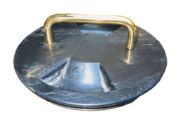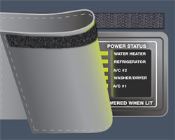Drain Plug Handle
Since my husband is not always available to drain the black and gray water tanks, I have had to take on this job. The tanks have disk-type drain plugs that are almost flat when screwed in properly. The only problem is that they are hard to get started and tend to cross thread when being screwed in. Also, it can be difficult to grip the small cutouts in the disk that are used to open or close the plug. So I went to a home improvement store, and for about $3 I bought some handles and attached them to the plugs. Now the plugs are easy to put in and take out, especially the sewer plug, which is used a lot when hooking up and removing the sewer hose through the hole.
Marilyn Hughes, F389273, Leeds, Alabama
Balloon Cushions
 When traveling in our motorhome, I prevent dishes and other items in the overhead cabinets from bouncing around too much by inflating a balloon and placing it in the cabinet. I tie the balloon off in such a way that it can be opened, deflated, and used again. Balloons are inexpensive and take up very little space when deflated. I also use them in the refrigerator. The balloons keep items from falling out when the refrigerator or cabinets are opened.
When traveling in our motorhome, I prevent dishes and other items in the overhead cabinets from bouncing around too much by inflating a balloon and placing it in the cabinet. I tie the balloon off in such a way that it can be opened, deflated, and used again. Balloons are inexpensive and take up very little space when deflated. I also use them in the refrigerator. The balloons keep items from falling out when the refrigerator or cabinets are opened.
Norma Scism, F198425, Kingston, New York
Reminder Cards
When traveling, my husband takes care of the slideouts and leveling jacks, but when I am on the road alone, I can never remember the steps I need to follow to extend the slideouts and lower the jacks, since I rarely perform these tasks. As a reminder, I printed up several sets of directional cards, covered them in plastic, and keep them in the dashboard compartment. I usually forget to remove the slide bar lock, since it is over my head, but thankfully the card reminds me.
Arlene Chiarolanzio, F181694, Florham Park, New Jersey
With today’s LED displays on energy management systems, etc., it can be difficult to darken the bedroom for nighttime sleeping. My wife, for example, is sensitive to this excess light. To solve our problem, we used a strip of adhesive hook-and-loop fastening material and a piece of thick fabric. After cutting and hemming the fabric to a size adequate to cover the monitor panel, she sewed the loop side of the hook-and-loop fastening material to the fabric. We then pressed the adhesive hook side of the material to the wall on top of the panel. It takes seconds to attach or remove the cover.
Al Chabot, F371218, Merrimack, New Hampshire
Cleaning The Radiator Core
For some reason, on many diesel-pusher motorhomes the crankcase vent pipe exhausts directly in front of the radiator core. (This is particularly true of those with a Caterpillar engine.) The exhaust that comes out of the vent pipe is heavily laden with oil particles, and when these particles are pulled through the radiator core, they leave a residue that collects dirt and dust, which can clog the core and overheat the engine.
To find out whether your motorhome may be susceptible to this problem, look under your engine and see whether the vent pipe is exhausting behind or directly in front of your radiator core. If it vents behind, you shouldn’t have any problems. However, if the pipe is venting in front of the radiator, the radiator eventually will become clogged with the oily dirt and dust.
In this case, have your service provider order the replacement vent pipe, which is longer and is angled to vent behind the radiator core. Following the installation, I recommend having your radiator power-washed using a cleaner that will dissolve the accumulated oily deposits on the radiator. Don’t think that a clean core from the rear of the motorhome means a clean core on the engine side. When I power-washed my clean core from the rear of the motorhome, I was astonished by the amount of dirt and grime that resulted.
Bob Steinweg, F301070, Plano, Texas
Editor’s Note: Be very careful using a pressure washer to clean the radiator. The extreme water pressure can damage vital parts if caution is not used. We suggest instead using a strong degreaser, garden hose, and sponge to remove the deposits on the radiator.
{loadpositionEndBlurbTips}


